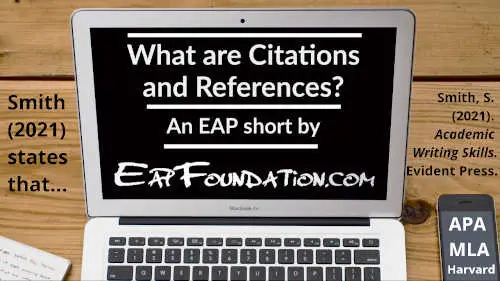Show AWL words on this page.
Show sorted lists of these words.


 







|
The in-text citations are a key part of a researched academic paper. This page first addresses what in-text citations are, then looks at citation formats for the three most common referencing conventions, namely Harvard, APA (7th edition) and MLA (8th edition).
What are in-text citations?
In-text citations are used in the main body of the text and are a short-hand format for works which are cited or referenced (i.e. referred to) in your writing. Citations normally contain the author's (or authors') surname(s), year of publication, and page number. They serve as pointers to the full details which are found in the reference section (or works cited list). The reason why this short-hand format is used is that in the text, it is important to acknowledge the source without using up too many words. If the reader wishes to locate the source document, he or she can refer to the reference section.
The following (in bold) are examples of in-text citations.
- Pears and Shields (2012, p.4) state that in-text citations give abbreviated details of works cited.
- University of Maryland University College (2016) indicates that the abbreviation et al. should be used when there are four or more authors.
In-text citation formats
This section gives information on in-text citations for the three most common formats, namely Harvard, APA and MLA.
Harvard
The Harvard style, despite its American origins, is the most common system used in the UK. It uses an author-date format. The exact format will vary depending on how the citation is incorporated into the sentence. If it is used as the subject of the sentence, with a reporting verb, then the year is put in parentheses (brackets) after the author's name. If, however, it is used in the middle or at the end of the sentence, without a reporting verb, then the author's name as well as the year are put in parentheses. See the following examples.
- University of Maryland University College (2016) indicates that the abbreviation et al. should be used when there are four or more authors.
- The abbreviation et al. should be used when there are four or more authors (University of Maryland University College, 2016).
The following are some other regulations for in-text citations using the Harvard style, depending on different situations, with examples given for each one.
| Situation | Details needed | Examples |
| Direct quotations are used, or ideas come from a specific page. | The page number should be used with the abbreviation p. for one page or pp. for more than one page (not possible for information from the internet, which does not have page numbers). |
|
| There are four or more authors for the work cited. | The name of the first author should be used, followed by the abbreviation et al., which is short for the Latin phrase et alia meaning 'and others'. |
|
| Identical information is taken from more than one source, and all sources are cited. | Use 'and' if a reporting verb is used, or a semi-colon (;) to separate the citations for end-of-sentence citations. The latter is more common |
|
| No year is given (e.g. for internet sources). | Use 'n.d.', which is short for 'no date'. |
|
| Two different works by the same writer, published in the same year, are cited. | Use 'a' and 'b' with the year to differentiate them. Similar labelling should be used in the reference section to make the works distinct. This situation is common when using internet sources, as each URL from the same website must be referenced separately. |
|
| Information is used which is cited in another source. | If possible, find the original source, read it and cite directly. If this is not possible, use 'quoted in' or 'cited in' and list both the original source and the one it is cited in. |
|
| No author is given. | Use the title instead of the author's surname. Occasionally there may be no author or title; in this case, use the URL (this case will only happen for internet sources). Generally, however, such sources should be avoided, as if you do not know who wrote the information, you may not be able to tell if it is reliable. | No examples are given here. Students are strongly recommended to use only sources where the author is clearly stated. Often this is given after the © copyright sign at the end of the page. |
APA
The APA (American Psychological Association) style of referencing is used in social science subjects, especially in the USA. It is very close to the Harvard style. There are only two differences for in-text citations, which are as follows:
- the abbreviation et al. is used when there are three or more authors for the work cited (not four, as with the Harvard style)
- if there are two or more authors, and the work is cited in parentheses, the symbol & should be used to link the names; note that if a reporting verb is used and the in-text citation is used as the subject, the format is the same as for the Harvard style
The following is an example of the second point above.
- The abbreviation et al. should be used when there are three or more authors (Pears & Shields, 2012, p.4).
MLA
The MLA (Modern Language Association) referencing style is used in some humanities subjects, including language and literature, especially in the USA. It is an author-page format, in contrast to the author-date format of the Harvard and APA styles. The main differences between MLA and those styles are as follows:
- the author's first name(s) can be used along with the surname
- the year is not used
- for page numbers, the numbers are given without using p. or pp.
- no comma is used between the name and the page
- when there is more than one work by the same author, a shortened form of the title is used to distinguish them
As with APA, the abbreviation et al. is used when there are three or more authors for the work cited (not four, as with the Harvard style).
The following examples show these features.
- The abbreviation et al. should be used when there are three or more authors (Pears and Shields 4).
- Pears and Shields indicate that the abbreviation et al. should be used when there are three or more authors (4).
- Smith states that Harvard in-text citations are the most commonly used in the UK ("In-text citations"). Smith further states that reporting verbs are essential when using in-text citations, and that there are many such verbs, each with subtle differences in meaning ("Reporting verbs").
Checklist
Below is a checklist for in-text citations. This only contains the main points above, as some may not apply (e.g. it is unlikely you will have two works by the same author with the same year). Use it to check your own writing, or get a peer (another student) to help you.
| Item | OK? | Note/comment |
| The author's name has been included for all in-text citations. | ||
| The year has been included if Harvard or APA styles are used, or page number for MLA style. | ||
| Page numbers are used for direct quotations for Harvard or APA styles. | ||
| If there are four or more authors (or three or more for APA and MLA styles), the first author has been used with the phrase 'et al.'. | ||
| If there is no year, 'n.d.' has been used for Harvard or APA styles. |
References (for page content)
Pears, R. and Shields, G. (2013) Cite them right: The essential guide to referencing. 9th edn. Basingstoke: Palgrave MacMillan.
Russell, T., Brizee, A., Angeli, E., Keck, R., Paiz, J., Campbell, M., Rodríguez-Fuentes, R., and Kenzie, D. (2014) MLA In-Text Citations: The Basics. Available at: https://owl.english.purdue.edu/owl/resource/747/02/ (Access date: 31/12/2015).
University of Maryland University College (2016) MLA Citation Examples. Available at: http://www.umuc.edu/library/libhow/mla_examples.cfm. (Access date: 1/1/2016).
References (for examples)
Atkinson, P. and Hammersley, M. (2007) Ethnography: Principles in Practice. 3rd ed. Abingdon, Oxon: Routledge.
Bassey, M. (2012) Case Studies, Chapter 11 in Briggs, A.R.J., Coleman M. and Morrison, M. (eds) Research Methods in Educational Leadership and Management, London: Paul Chapman, pp.155-169.
EIT Online (n.d.). Reporting Verbs. Available at: http://www2.eit.ac.nz/library/ls_guides_reportingverbs.html (Access date: 17/6/16)
Leithwood, K., Louis, K. S., Anderson, S., & Wahlstrom, K. (2004) How leadership influences student learning. New York: Wallace Foundation.
Lyman, S.M. and Scott, M.B. (1970) A Sociology of the Absurd. New York: Appleton-CenturyCrofts.
Smith, S. (2016a) In-text citations. Available at: https://www.eapfoundation.com/writing/references/section/ (Access date: 18/6/16)
Smith, S. (2016b) Reporting verbs. Available at: https://www.eapfoundation.com/writing/references/reporting/ (Access date: 18/6/16)
Next section
Find out about reference sections in the next section.
Previous section
Go back to the previous section about references and citations.






